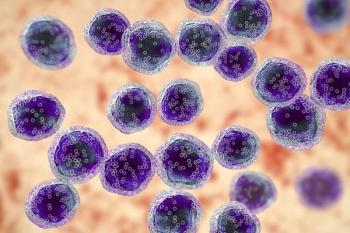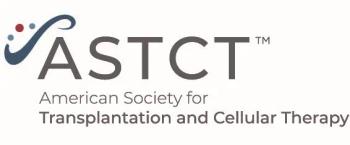
Bisphosphonate Effective in Treating Osteonecrosis Pain in Pediatric ALL
Use of the bisphosphonate pamidronate (Aredia) may be “more efficient” than standard regimens as palliative treatment for symptoms of acute symptomatic osteonecrosis in pediatric patients with acute lymphoblastic leukemia.
Use of the bisphosphonate pamidronate (Aredia) may be “more efficient” than standard regimens as palliative treatment for symptoms of acute symptomatic osteonecrosis in pediatric patients with acute lymphoblastic leukemia (ALL), according to a team of researchers at the Sainte-Justine University Hospital Center in Montreal. The investigators evaluated 17 children who developed symptomatic osteonecrosis as a complication of treatment among 220 pediatric patients treated at the hospital for ALL over an 8-year period. The median age at ALL diagnosis was 11 years (range: 2.7–16.6 years). No patient was younger than age 3 years at the time of osteonecrosis diagnosis.
Bone marrow smear from a patient with ALL; source: Furfur, Wikimedia Commons
The aim of the study was to assess outcomes (such as pain relief, motor function, and radiological evolution of osteonecrosis lesions) of pamidronate treatment, as compared with standard care, in ALL patients with osteonecrosis during their first remission, and to study whether some patients might continue to receive steroids after diagnosis of osteonecrosis. Findings were
Of the 17 children, 14 were treated with intravenous (IV) pamidronate and 3 were treated with supportive care alone. “Some oncologists were not familiar with the use of bisphosphonates and the idea that this new intervention might interfere with the efficacy of chemotherapy was one of the main arguments for refusal,” explained the authors, led by Coralie Leblicq, MD, of the Endocrinology Service and Research Center, CHU Sainte-Justine, Department of Pediatrics, University of Montreal. All children were treated according to the Dana Farber Cancer Institute protocols (2000-01 and 2005-001). In both protocols, prednisone was used during the induction period (28 days for protocol 2000-01 and 32 days for protocol 2005-001).
In the 2000-01 protocol, patients were randomized between prednisone and dexamethasone during the intensification and consolidation periods. In the 2005-001 protocol, only dexamethasone was used after the induction period. All patients stopped corticotherapy at the time of osteonecrosis. In some cases corticotherapy was reintroduced after control of symptoms with bisphosphonate treatment. All patients received supportive care including calcium–vitamin D supplements and physiotherapy. Initial pamidronate doses were 0.5 mg/kg on day 1 and 1 mg/kg on days 2 and 3, followed by courses of 1 mg/kg/day for 3 days every 4 months until 6 pain-free months or the end of therapy, whichever came later.
Pain and motor function scores were recorded at diagnosis and at each visit after pamidronate infusion as well as at the end of the ALL protocol. Osteonecrosis diagnosis was confirmed by magnetic resonance imaging (MRI) of the symptomatic joints. Additional MRI scans were performed after 6 to 72 months depending on clinical evolution. Hip, knee, and ankle joints were affected. According to MRI results, the radiologist classified the lesions at diagnosis and during follow-up as mild, moderate, or severe.
“In our cohort, patients showed a significant improvement of their clinical evolution with resolution of pain in 77% of patients and improvement in function in 59% of patients, one to four months after pamidronate,” the investigators reported. “Long-term evolution showed absence of pain in 84.6% of children and improvement of function in 75% of patients.”
The authors acknowledged the limitations of the study, including its retrospective design, the small number of patients, and reintroduction of corticotherapy in some patients based on clinical evolution. “Therefore, larger prospective, randomized controlled studies are needed to confirm the efficacy of bisphosphonates on pain and motor function of [symptomatic osteonecrosis] and to assess their role in bone healing of osteonecrosis lesions relative to their severity,” they observed. Nevertheless, they concluded, “pamidronate use seems to be efficient as a palliative treatment in terms of pain relief and motor function improvement in the acute phase of [symptomatic osteonecrosis] secondary to ALL treatment compared to patients with [symptomatic osteonecrosis] treated with standard regimens.”
“The results of this study are interesting as they demonstrate that pamidronate decreases pain and improves motor function in a significant percentage of children with ALL developing osteonecrosis as a result of treatment for their disease,” commented Leonidas Platanias, MD, PhD, deputy director of the Robert H. Lurie Comprehensive Cancer Center and professor of oncology at Northwestern University Medical School, Chicago. “Further studies are needed, however, to confirm these findings and establish whether bisphosphonates may have a role in the prevention of osteonecrosis in childhood ALL patients.”
Newsletter
Stay up to date on recent advances in the multidisciplinary approach to cancer.


















































































